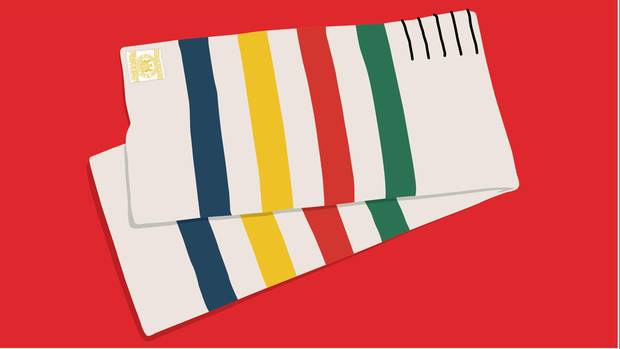To mark Canada 150, Globe Style's Clearly Canadian series explores iconic examples of domestic design.
The point blanket's name was inspired by the series of short dashes called "points" woven into the selvedge to indicate finished overall dimensions even when folded. The point system was used by traders to easily identify standard size – the largest is 8 point, or king sized – and was also used to indicate value. It was the bartering staple of North American trade between European colonials and indigenous peoples. According to point-blanket collector and historical expert Harold Lee Tichenor, author of The Blanket: An Illustrated History of the Hudson's Bay Blanket, by 1700, blankets represented more than 60 per cent of all goods exchanged in the fur trade.
The bold multi-stripe multicoloured graphic design dates back to 1798 and an order at Witney Mills, one of the original blanket suppliers in England. Hudson's Bay was not the only company to use the point system in blankets over the centuries, but thanks to 21st-century marketing extensions into many product categories, the striped blanket is now most closely associated with the company that takes its name from the region of Canada where it established operations.
First famously cut and sewn into capote wraps for British Captain Charles Roberts and his troops as they secured Mackinac Island during the war of 1812, the blanket's product extensions include coats and Converse plimsolls, Herschel bags and fashion collaborations with Canadian contemporary designers such as Jeremy Laing and Smythe, limited-edition Barbie dolls and cedar and fibreglass canoes handcrafted in Canada by historic purveyor Langford. In lieu of a red carpet, you'll even find a striped tapis at the star-studded Toronto International Film Festival.
The characteristic stripes are a potent cultural symbol, but they're also fraught, because of the persistent contention that trade blankets were historically used as a form of biological warfare by the British forces to infect First Nation populations with smallpox. Traditional striped coats and blankets also appear, pointedly, in several paintings of Canadian artist Kent Monkman's new Shame and Prejudice show, which is currently on a cross-country gallery tour. The works explore and question the accepted narrative about the 150 years before and after Canadian confederation.
Antique blanket devotees and avid collectors catalogue their finds on Tumblr and Pinterest, and new blankets are still sold at Hudson's Bay and through American purveyors like Woolrich and L.L. Bean. True HBC blankets bear a label of authenticity in one corner because of design copycats (Oregon mill Pendleton's Glacier Park blanket design, for example, features the same banded colours).
The traditional woollen blankets are manufactured at AW Hainsworth mill in Yorkshire, England, a textile company in existence since 1783. Hainsworth's predecessor Wormald & Walker manufactured the blankets and has enjoyed a trading relationship with Hudson's Bay since the 17th century.
Over the years, special versions of the blanket in pastel shades or jewel tones have been issued to commemorate events, coronations and state visits. One such limited-edition launch is this year's new design variation, the first since the turn of the millennium, to honour the sesquicentennial. In an understated marled dove grey with cream points and stripes, it's called the Ice Point blanket ($170-$550) as a tribute to the glaciers that account for most of the world's fresh water, of which Canada hosts about 20 per cent within its boundaries from sea to sea.
Visit tgam.ca/newsletters to sign up for the Globe Style e-newsletter, your weekly digital guide to the players and trends influencing fashion, design and entertaining, plus shopping tips and inspiration for living well. And follow Globe Style on Instagram @globestyle.
